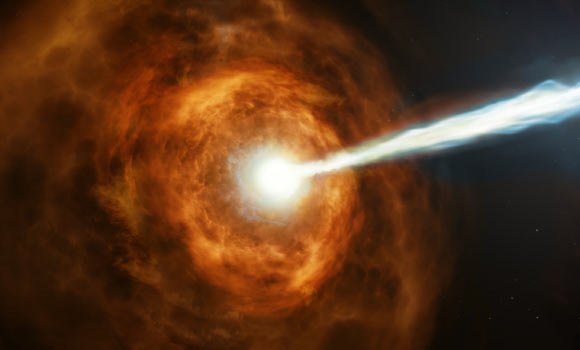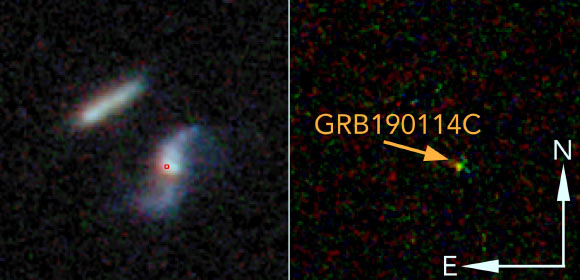Astronomers Observe Host Galaxy of Extremely Bright and Long Gamma-Ray Burst | Astronomy – Sci-News.com
Astronomers have investigated the nature of a very bright and long-duration gamma-ray burst, GRB 190114C, by studying its environment.

Hubble’s observations suggest that GRB 190114C displayed powerful emission because the collapsing star was sitting in a very dense environment, right in the middle of a bright galaxy 5 billion light years away. Image credit: NASA / ESA / Hubble / M. Kornmesser.
Gamma-ray bursts are the most energetic explosions in the Universe, beaming out mighty jets which travel through space at 0.99 times the speed of light, as a star much more massive than our Sun collapses at the end of its life to produce a black hole.
GRB 190114C was detected by a suite of telescopes, including NASA’s Swift and Fermi telescopes, as well as by the Major Atmospheric Gamma Imaging Cherenkov telescopes, on January 14, 2019.
Some of the light detected from the object had the highest energy ever observed: 1 TeV (Tera electron volt) — about one trillion times as much energy per photon as visible light.
Follow-up observations were made with the NASA/ESA Hubble Space Telescope to study the environment around GRB 190114C and find out how this extreme emission is produced.
“Hubble’s observations suggest that this particular burst was sitting in a very dense environment, right in the middle of a bright galaxy 5 billion light years away. This is really unusual, and suggests that might be why it produced this exceptionally powerful light,” said Dr. Andrew Levan a researcher at Radboud University.

GRB 190114C: the left panel shows a close pair of interacting galaxies, which is a host system of GRB 190114C; the location of GRB 190114C is indicated with a red circle; the right panel shows the optical counterpart of GRB 190114C. Image credit: de Ugarte Postigo et al, arXiv: 1911.07876.
The astronomers used Hubble, together with ESO’s Very Large Telescope and the Atacama Large Milimeter/submilimeter Array (ALMA), to study the host galaxy of GRB 190114C.
They investigated whether the environmental properties of the host system, which is composed of a close pair of interacting galaxies, might have contributed to the production of these very-high-energy photons.
GRB 190114C occurred within the nuclear region of a massive galaxy, a location that is rather unique.
This is indicative of a denser environment than that in which gamma-ray bursts are typically observed and could have been crucial for the generation of the very-high-energy photons that were observed.
“Scientists have been trying to observe very-high-energy emission from gamma-ray bursts for a long time,” said Dr. Antonio de Ugarte Postigo, a scientist in the Instituto de Astrofísica de Andalucía.
“This new observation is a vital step forward in our understanding of gamma-ray bursts, their immediate surroundings, and just how matter behaves when it is moving at 99.999% of the speed of light.”
A paper outlining the Hubble observations appears in the journal Nature.
An additional paper that details an analysis of the galaxy hosting GRB 190114C will be published in the journal Astronomy & Astrophysics.
_____
V.A. Acciari et al. 2019. Observation of inverse Compton emission from a long γ-ray burst. Nature 575: 459-463; doi: 10.1038/s41586-019-1754-6
A. de Ugarte Postigo et al. 2019. GRB 190114C in the nuclear region of an interacting galaxy — A detailed host analysis using ALMA, HST and VLT. A&A, in press; arXiv: 1911.07876





